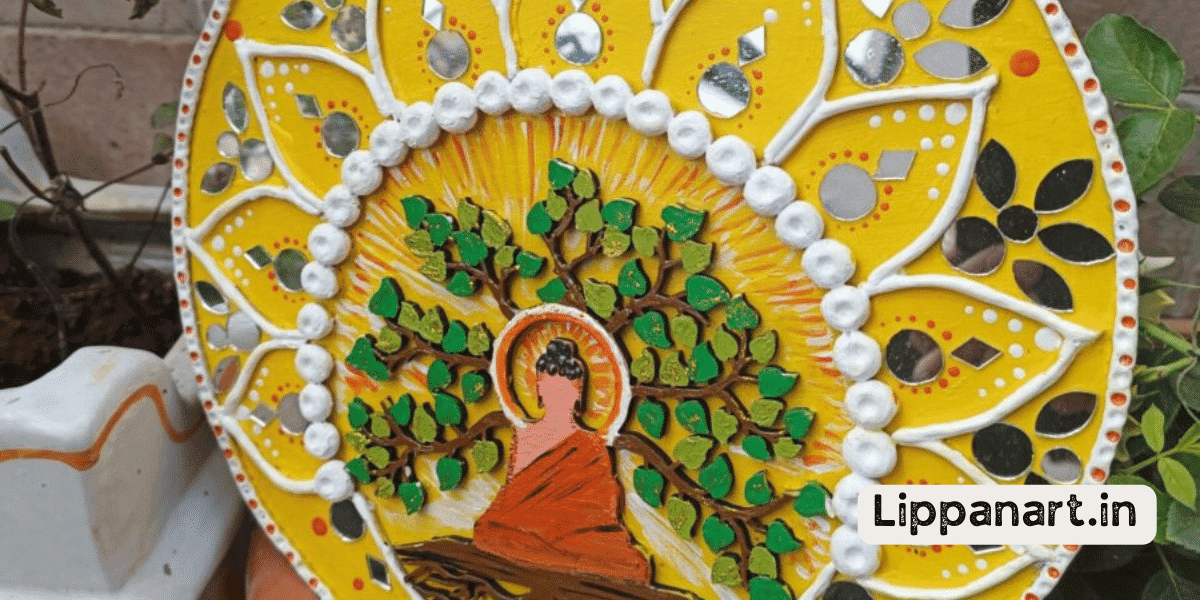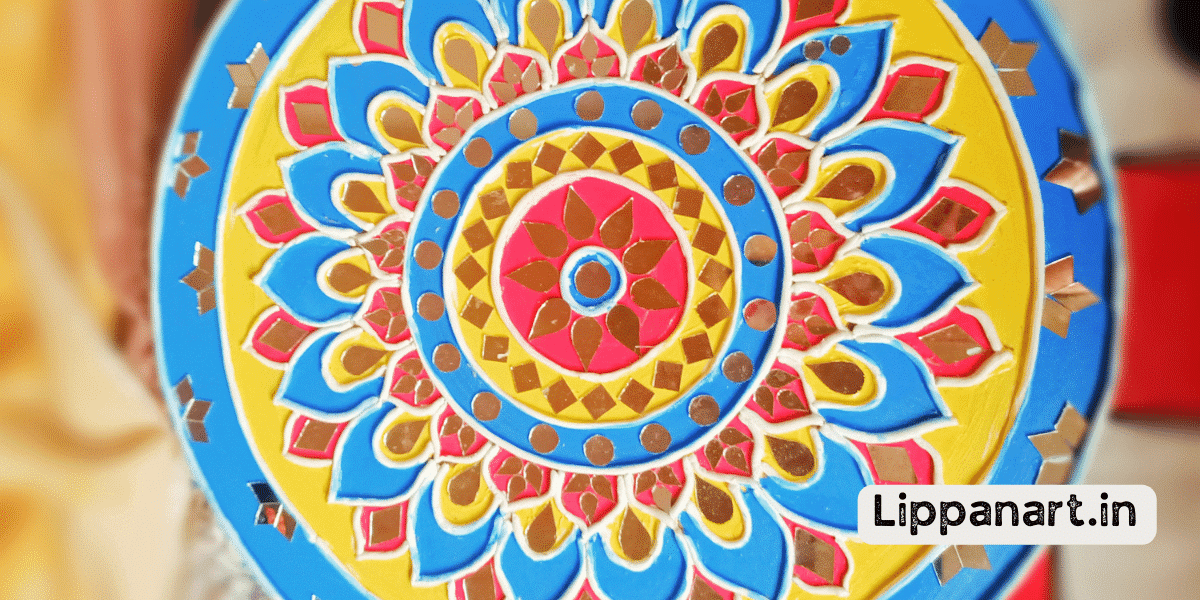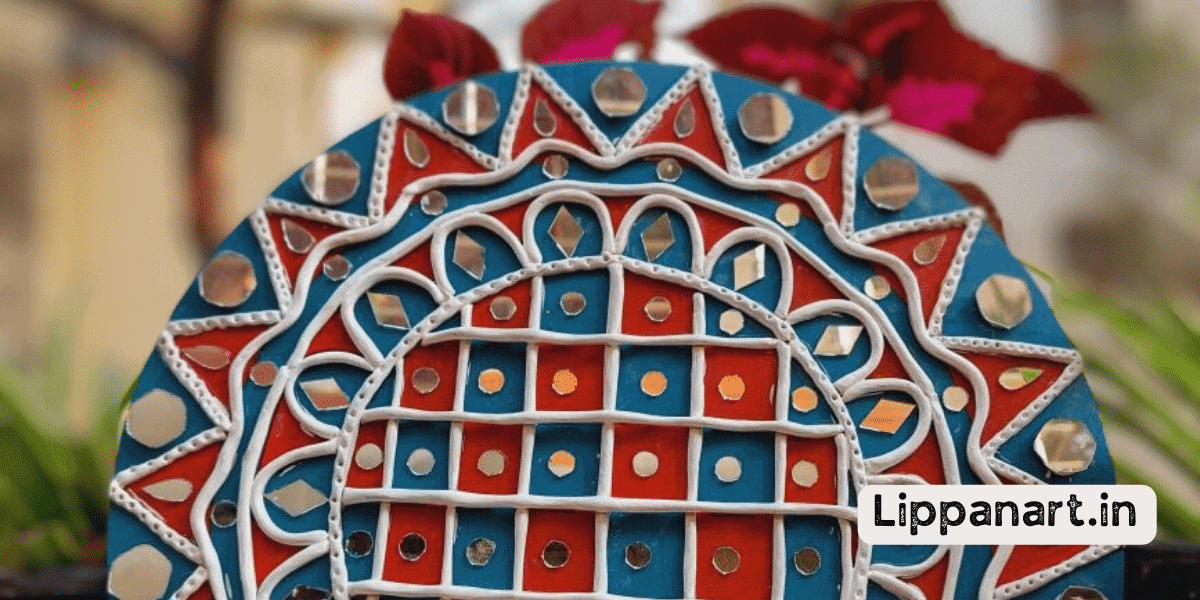Contrasting materials and techniques create a beautiful and unique work of art that is mud and mirror work. This art form has been crafted in India for centuries, but its bright colours and intricate designs still inspire people today.
You may wonder what this art form is and how it has been used in Indian culture. Read on to learn mud and mirror work’s history, techniques, symbolism, and contemporary applications.
History of Mud and Mirror Work in India
You’ve likely heard of mud and mirror work in India, with its long history of being used in decorations and ceremonies. This ancient craft, originating in the Kutch region of Gujarat, has been passed down through generations. It is still used today to create one-of-a-kind and stunning art pieces.
The tradition of decorating homes with mud and mirror work is said to have originated centuries ago when mirrors were used to ward off evil spirits. The mirrors are embedded in the mud, and then the mud is sculpted into patterns and motifs. The mirrors reflect the light, giving an ethereal, almost magical effect. This type of craftwork has become an integral part of Indian culture and is often used to decorate weddings and festivals.
Today, mud and mirror work is still popular in India and is used to create everything from wall hangings to table decorations. The materials used for this craft are still traditional, and the process is largely unchanged. The artisans use their hands to form the mud and then correctly place the mirrors. The resulting pieces are stunning and can add a unique touch to any home.
Mud and mirror work is an ancient craft with a long history in India. It is still used today to create beautiful art pieces that will stand out in any home. By combining mud and mirrors, artisans can create intricate patterns and motifs that reflect the light and bring a unique and magical beauty to any space.
Materials and Tools Used in Mud and Mirror Work
To create stunning designs, you’ll need specific materials and tools. Crafting mud and mirror work requires a few essential components to get started. Clay is the main element of the art form, as it’s used for the base of the design and hardened with water. Mirrors add sparkle and shine to the piece. The clay is then cut into shapes and formed to create a visually appealing design. You’ll also need a sharp knife to cut the clay into the desired shapes and a small brush to add the finishing touches.
| Material | Use |
|---|---|
| Clay | Provides the base of the design |
| Mirrors | Adds sparkle and shine |
| Sharp Knife | Cuts clay into desired shapes |
| Small Brush | Adds finishing touches |
Traditional Techniques and Patterns in Mud and Mirror Work
Traditional techniques and patterns have been used for centuries to create stunning mud and mirror art pieces. From intricate geometric designs to delicate floral motifs, the possibilities are endless. Each design uniquely expresses the artist’s vision and creativity, crafted with precision and skill. Mud and mirror work is an art form that requires an understanding of basic form and shape combined with an appreciation of the beauty of reflective materials.
The process of creating mud and mirror work involves the careful placement of mirrors and other decorative objects within a mud frame. This is then embellished with intricate patterns, often inspired by traditional designs. The mirrors are carefully cut and placed to create a unique, eye-catching piece of art. By manipulating the pattern and form of a piece, one can create various effects ranging from subtle to dramatic.
For centuries, the art of mud and mirror work has been utilized to produce breathtaking works of art that stand the test of time. It allows artists to create intricate designs, combining mud and mirror in unique and creative ways. Whether the goal is to create a stunning piece of art or to bring a bit of cheerful colour to a room, mud and mirror work is a perfect choice for those who desire innovation.
Regional Variations and Styles in Mud and Mirror Work
From region to region, you’ll find different styles and variations of art created with mud and mirror. For instance, in Gujarat, the traditional lippan kaam art is created with mud and mirror, usually in the form of wall hangings. These hangings are found in rural communities and often adorn people’s houses. In Rajasthan, the art form creates elaborate doorways and arches with intricate patterns framed by mirrors. In Maharashtra, the art form creates unique idols of Hindu gods and goddesses.
| Style | Region |
|---|---|
| Lippan Kaam | Gujarat |
| Doorways & Arches | Rajasthan |
| Idols | Maharashtra |
In Tamil Nadu, the art form is often used to create beautiful peacocks, with mirrors being used to highlight the vibrant colours of the feathers. In Karnataka, the art form is used to create beautiful abstract patterns, often inspired by nature. The mirrors give the art a sense of depth and dimension, adding to its beauty. In Andhra Pradesh, the art form is used to create large panels that depict stories from Indian mythology and folklore.
No matter the region, the art of mud and mirror work is an integral part of the culture and heritage. It expresses the people’s creativity and a way to preserve their traditions. It is also a way to bring beauty and joy to the communities.
- Editor’s Choice
- Best Seller
- Amazon Choice
Significance and Symbolism of Mud and Mirror Work in Indian Culture
You’ll find that mud and mirror art is deeply rooted in Indian culture and has great significance and symbolism. It is used to decorate the walls and furniture of homes and often adorns the walls of temples and shrines. Mud and mirror work is also an important part of traditional Indian weddings, used to create beautiful decorations for the bride and groom.
Here are a few ways that mud and mirror work is significant in Indian culture:
- Wooden panels are often adorned with intricate patterns and designs made from mud relief, representing the bride and groom’s union and their families.
- Artisans use glass, clay, and mirror materials to create striking designs and patterns, signifying the importance of creativity and resourcefulness.
- The use of mud and mirror work is a way of honouring and celebrating India’s rich culture and history.
- Mud and mirror work is often used to create beautiful pieces of art that bring a sense of joy and beauty to the home.
These are just a few ways mud and mirror work is significant and symbolic in Indian culture. This unique art form is not only a source of beauty and creativity, but it is also a way to honour and celebrate the history of India.
Contemporary Applications of Mud and Mirror Work
Today, you can find contemporary applications of this art form in many places, such as jewellery, clothing, and home decor.
Mud and mirror work is an ancient Indian art form that uses motifs and patterns to create beautiful works of art. Mirror painting is a popular form of this art, and it can be used to decorate walls, furniture, and even jewellery.
Mud relief art is another form of this art form that is used to create intricate designs on walls and furniture. The art form is both beautiful and unique, and it is a great way to bring a touch of Indian culture into your home.
It can add a unique look to any space, and the intricate designs are sure to catch anyone’s eye. This art form is perfect for anyone who desires a one-of-a-kind, innovative look in their home.
Whether you’re looking for an eye-catching piece of jewellery or a unique wall design, mud and mirror work can provide the perfect solution.
Preservation and Revival of Mud and Mirror Work
Preserving and reviving mud and mirror work ensures this art form thrives. Mud mirror art is a mixture of clay and mirrors used by cultures worldwide for centuries. It has been used in many ways, from adornment to religious ceremonies. Lipan Kaam, the practice of using mud and mirror work to invoke the power of the gods, is an example of how it has been used for centuries. Today, preserving and reviving this unique art form can help ensure its continued existence.
Here are some ways to help preserve and revive mud and mirror work:
- Celebrate the art form with festivals and exhibitions.
- Educate people about the history and significance of the craft.
- Support artists and artisans who are still practising the craft.
- Encourage new generations to learn the craft and share it with others.
We can ensure its long-term survival and revival by coming together to support and celebrate this unique art form. As a result, more people will be exposed to the beauty and power of mud and mirror work and be able to appreciate its cultural and spiritual significance.
It’s a creative, insightful, and engaging way to honour the craft and ensure its legacy lives on.
Tips and Tricks for Creating Mud and Mirror Work Designs
Creating your own mud and mirror work designs is an exciting and meaningful way to express yourself and add beauty to your home. To get started, you’ll need a few supplies: dung, a mixture of mud and water, and various small mirrors. From there, the possibilities are endless! Here are some tips and tricks to help you design beautiful and creative mud and mirror work:
| Step | Description | Benefits |
|---|---|---|
| 1 | Prepare the dung and mud mixture | Creates a durable canvas for your design |
| 2 | Place your design on the canvas | It allows you to visualize the result |
| 3 | Attach the mirrors to the canvas | Adds sparkle and depth to your design |
| 4 | Enhance with paint or other objects | Creates a unique, personalized design |
| 5 | Display your finished creation | Enjoy the beauty of your masterpiece! |
Creating mud and mirror work is a fun and rewarding experience. With a little creativity and the tips above, you can create a beautiful work of art that will bring a unique and eye-catching sparkle to any room in your home. So what are you waiting for? Get started and show off your creative side!
Frequently Asked Questions
Are There Any Online Classes for Learning Mud and Mirror Work?
Yes! There are various online courses available that can assist you in enhancing your mud and mirror techniques. Get creative, gain insight, and discover new ways to innovate. Enhance your knowledge and open up a world of possibilities.
Is Mud and Mirror Work Suitable for Beginners?
Yes! Mud and Mirror Work is a great way to explore creative expression and gain insight into yourself. It’s a great starting point for beginners – simple yet profound. Explore and discover your unique creative potential!
How Long Does It Take to Complete a Mud and Mirror Work Project?
Discovering the duration of a project depends on many factors. The time taken to complete a project is unique and can vary from complexity to creativity. Uncovering the answer requires exploration, as each endeavour is distinct. So, how long will yours take? A journey of a thousand miles begins with a single step.
Are There Any Health and Safety Considerations When Doing Mud and Mirror Work?
It’s important to consider health and safety when undertaking any project. Wear protective clothing, follow safety guidelines, and use the right tools to prevent accidents and injury. Be mindful of your environment to ensure a successful outcome.
Conclusion
Mud and mirror work is a unique art form used to bring beauty to India for centuries. It’s intricate designs and vibrant colours make it an art form that can evoke emotions in its viewers.
It is a form of art still alive and well today, just like a phoenix rising from the ashes of time. Mud and mirror work is more than just a craft; it is an integral part of India’s culture and should be respected and celebrated for its beauty and history.
Creating art can bring warmth and happiness to your living space with patience and creativity. Create beautiful art to brighten up your home with patience and creativity.














